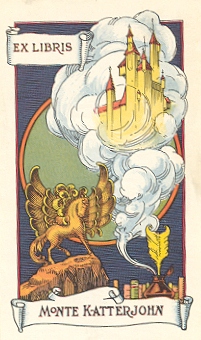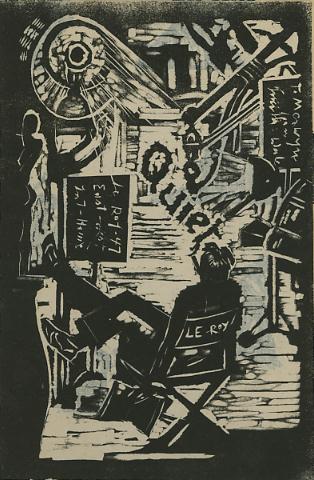|
|
|
|
This
is, I guess, the ur-Hollywood bookplate, representing as it does
not any individual book collector but the industry's own library,
so to speak. The Academy was founded in 1929, and almost immediately
began to assemble a collection of books on the, well, arts and sciences
of the motion picture. Once someone decided that the books (in the
beginning accessible only to Academy members in a sort of "club
room") should actually be thought of as a "library,"
this bookplate -- which was done early enough in the organization's
history to feature its original logo (which would later become more
streamlined) -- was put into use. (I'm in the middle of trying to
figure out exactly how long it was used, which will take some time.
The example presented here was scanned from a book published in
1935.)
|
According
to the eminent bookman/bookseller James Pepper, this plate is "generally
considered the finest bookplate from the Golden Age of Hollywood,"
an assessment with which it's hard to argue, on the basis of sheer
star-power alone. The identity of this plate's designer (perhaps
an anonymous studio employee of either Doug or Mary) is unknown,
as is the date of its creation -- although from both the internal
and external evidence, it cannot have been earlier than 1920 --
which is the year the couple were married, and the year in which
THE MARK OF ZORRO (in which titular role Fairbanks is here depicted)
was released. (Mary, I believe, is shown here as REBECCA OF SUNNYBROOK
FARM, in which she appeared in 1917; at least that's what Jim Pepper
says, although I plan to verify this with the world's foremost Mary
P. authority.)
|
Like
many Hollywood creative types, director Mark Sandrich (best known
for his sparkling and innovative direction of several of the Astaire-Rogers
musicals) was a bit of a book hound, and adorned his better tomes
with this truly wonderful (and occupationally-themed) bookplate --
designed (again, by an unknown designer, or at least unknown to me).
|
 |
 |
The
plate at the left, a custom design for producer-director Mervyn LeRoy,
frustrates me a bit, because it's obviously signed by its designer (in
that little rectangle near the upper right corner), but I can't make out
the signature! The date is also a bit problematic, but I have two conjectures,
both based on the information on the "slate" at left center,
which reads: "Le Roy - 47 / East - West / Int. - Home"
Theory 1: the plate dates from the late 1940s, with "East - West"
referencing the film EAST SIDE, WEST SIDE, which LeRoy directed for MGM;
it was released in 1949, which would make "47" a little suspect
as a date (the film might have been in production in 1948, but probably
not as early as 1947, although I have not researched this). However, I'm
not altogether comfortable with a late-40s date, simply because to my
eye the plate has a very definite Thirties "look" to it. (It
was also found in a book published in 1929, although obviously the bookplate
could have been designed at a later date and "retroactively"
affixed to an older book). At any rate, this leads me to Theory #2, which
dates the plate ca. 1932 --this based on the fact that LeRoy directed
a picture for Warner Bros. that year entitled THE HEART OF NEW YORK --
the pre-release title of which was "East Side." The "47,"
in this scenario, would represent not a date, but possibly either (a)
a scene number, or (b) a production number. (I also have a wild hunch
-- unsupported by any evidence -- that the designer might have been the
great art director Anton Grot....who then worked at Warners and was, in
fact, the art director on THE HEART OF NEW YORK. Try as I may, however,
I can't quite get "Anton Grot" out of that "signature"
on the right-hand side, no matter how much I stare at it.) Anyway, all
that aside...ain't it cool? Note that it was also a rather large plate,
measuring approximately 5x7 inches -- the sort of thing that Edward Gordon
Craig, in his 1925 book Nothing; or The Bookplate, called "an
absurdity...annoying...ponderous....rather too like a person who is trying
to make a fuss." In other words: Hollywood, all the way! |
| Monte
Katterjohn was an early-day screenwriter, about whom I know little, but
from whose filmography I surmise may have had a little trouble with writing
convincing dialogue. His credits begin in the pre-feature film era (1912)
and by 1928 he had received credits on 60 films, including THE SHEIK ((this
according to the Internet Movie Database, which is hardly infallible in
this era). Then came the talkies, for which he had exactly four, count
'em four, more credits, ending inauspiciously in 1931 with a shared adaptation
credit on Paramount's Fu Manchu potboiler DAUGHTER OF THE DRAGON. He lived
on until 1949, but (apparently) never worked again. According to the six-line
obituary accorded him by The New York Times, he died of a heart attack
at the age of 57 -- and not even in Hollywood, but in Evansville, Indiana,
exactly 19 miles from his hometown of Boonville. (And do the math: he
hadn't yet hit his 40th birthday when DAUGHTER OF THE DRAGON was released.
Ah well, you know what they say: "Live fast, die young, and leave
a good-looking bookplate." Or something like that.). |
|
|
|
|
| |
Barrymore, Zanuck, and Schildkraut
plates courtesy of Anthony Slide.
|
|